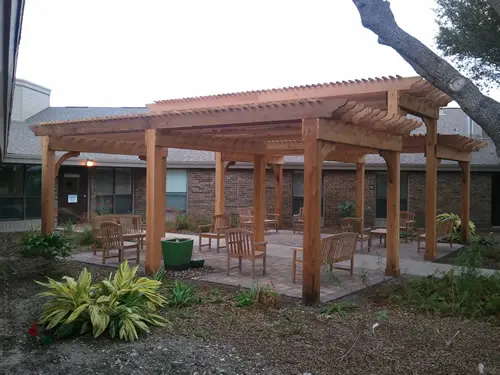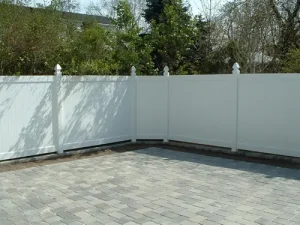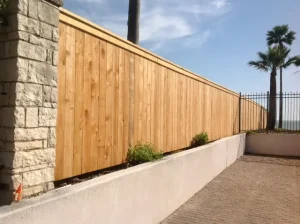![The Great Fence Debate Wood Versus Vinyl [How to Choose]](https://www.dcfence.com/wp-content/uploads/2024/04/The-Great-Fence-Debate-Wood-Versus-Vinyl-How-to-Choose-300x157.webp)
The Great Fence Debate: Wood Versus Vinyl [How to Choose?]
When it comes to enhancing the privacy, security, and aesthetic appeal of your home, few elements play as pivotal a role as your choice of

Are you looking to transform your outdoor space into a picturesque haven? Look no further than patio covers. These versatile structures provide shade and protection from the elements and add a touch of elegance to your patio.
However, with many materials available, choosing the right one can take time and effort. We unveil the best materials for stunning patio covers, ensuring that you make an informed decision to create a beautiful and functional outdoor oasis.
When it comes to wood patio covers, their timeless appeal and ability to blend with any architectural style make them a popular choice. Opt for durable wood options like cedar, redwood, or pressure-treated lumber that resist rot and insects.
It’s important to remember that wood covers require regular maintenance, including sealing, staining, and inspections, to protect against weathering and ensure longevity. You can enjoy your wood patio cover for years in your outdoor space by following proper maintenance practices.
Aluminum patio covers offer a versatile and modern solution for outdoor living spaces. The lightweight nature of aluminum makes it easy to work with and allows for various styles and designs, ranging from sleek and minimalistic to ornate and decorative. One of the main advantages of aluminum covers is their low maintenance requirements. They are resistant to rust, rot, and insect infestation, making them highly durable.
However, aluminum covers may have drawbacks in extreme weather conditions as they can be prone to denting and may not provide the same level of insulation as other materials. With proper care and occasional cleaning, aluminum patio covers can have a long lifespan, making them a popular choice for homeowners seeking a combination of style and practicality in their outdoor spaces.
Vinyl patio covers have gained popularity for their appeal and versatility. They offer a clean and contemporary look that can complement various architectural styles. Vinyl covers come in multiple colors and textures, allowing for ample customization options to suit individual preferences. One of the significant benefits of vinyl covers is their low maintenance requirements.
They resist fading, cracking, and peeling, making them durable and long-lasting. It’s important to note that vinyl covers may have limitations in extreme weather conditions, as they can expand and contract with temperature fluctuations. Regular cleaning with mild soap and water is usually sufficient to keep vinyl covers looking their best, making them a convenient choice for homeowners seeking a hassle-free outdoor living solution.
Steel patio covers offer exceptional strength and sturdiness, making them ideal for those seeking durability and long-term reliability. Steel covers can withstand heavy loads and are resistant to warping, cracking, and rotting. Steel covers offer versatility in style and design choices, allowing for various configurations and architectural designs.
One of the significant advantages of steel covers is their ability to provide superior protection against harsh weather conditions, including heavy rain, snow, and strong winds. Steel covers may require proper insulation and ventilation to control condensation and heat buildup. Regular maintenance, such as rust or corrosion inspections and repainting, can extend the lifespan and enhance the aesthetic appeal. It ensures years of dependable performance.
Polycarbonate patio covers have gained popularity for their unique properties and versatility. Polycarbonate is a durable, lightweight, and impact-resistant material with excellent UV protection. Polycarbonate covers can be transparent or translucent, depending on homeowners’ natural light and privacy preferences. The advantages of polycarbonate covers include their ability to filter harmful UV rays, provide insulation, and offer a lightweight alternative to traditional materials.
Polycarbonate patio covers come with limitations in extreme temperatures. They tend to expand and contract, which is vital to bear in mind to ensure durability. Proper maintenance and cleaning, including mild soap and water, is ideal. It’s also essential to occasionally check for cracks or damage to ensure their performance. These covers provide an elegant solution to your outdoor space, keeping dust and debris at bay while enhancing the area’s aesthetic.
Fiberglass patio covers offer a unique combination of strength, versatility, and aesthetic appeal. These covers are constructed with glass fibers and resin, resulting in a lightweight yet durable material. Regarding design and aesthetic options, fiberglass covers come in various colors, finishes, and textures, allowing customization to suit different architectural styles. The advantages of fiberglass covers include their resistance to fading, cracking, and warping and their ability to provide good insulation.
Did you know that fiberglass covers may turn yellow when exposed to sunlight over time? But don’t worry; you can easily protect your patio covers. Regular cleaning with a mild detergent and a gentle scrub followed by a protective wax or gel coat application can help maintain the fiberglass covers’ look and durability.
Fabric patio covers are a great way to create comfortable outdoor spaces that are shaded and stylish. Thanks to the extensive design and functionality options, canopy coverings offer flexibility and portability. Covers made of canvas, polyester, or acrylic provide filtered sunlight, making them perfect for relaxing in cool shades. Nevertheless, it’s essential to be aware that fabric covers can be less durable than other materials and may have limitations in resistance to weather conditions.
So, regular cleaning is a must. Remember to remove debris and periodically wash it with mild soap and water to maintain its appearance and prolong its lifespan. Finally, resealing or retreatment with water-repellent solutions may be required for some covers to enhance water resistance.
When choosing a patio cover material, consider the climate, desired aesthetics, budget, maintenance requirements, and longevity. Factors such as weather conditions and style preferences will influence the choice.
It is also important to take long-term maintenance costs into account. Considering these factors, you can make an informed decision that suits your needs and creates an appealing and durable patio cover.
To select the perfect patio cover material, one must weigh the advantages and disadvantages of each option. Wood is beautiful but requires maintenance. Aluminum is versatile but may lack insulation. Vinyl is durable but can be affected by extreme temperatures. Steel is strong but may need insulation and ventilation.
Polycarbonate offers UV protection but can expand and contract. Fabric covers are portable but may need to be more durable. By understanding the pros and cons, you can choose the material that best suits your needs and preferences for your patio cover.
When installing a patio cover, consider permit requirements, structural considerations, installation options, and ongoing maintenance. Permits and regulations must be followed while ensuring the structure’s stability and proper anchoring.
Professional installation guarantees expertise and adherence to building codes. Regular maintenance, including cleaning and repairs, is necessary to maintain the patio cover’s longevity and functionality.
Add accessories and features to enhance your patio cover and create a more enjoyable outdoor space. Installing lighting options like string lights or solar-powered lanterns can create a cozy atmosphere. Ceiling fans improve ventilation and provide cooling during hot days.
Adding decorative elements such as potted plants, outdoor curtains, or artwork adds style and personalization. Installing rain gutters and implementing effective water management is vital to protect your patio and surrounding areas from water damage.
Maintaining and cleaning patio covers is crucial for their durability and appearance. Regular cleaning with a mild soap and water solution keeps them looking their best. You can use solutions like vinegar, water, or mild bleach to remove tough stains.
Following a seasonal maintenance checklist, including checking for loose screws, inspecting for damage, and ensuring proper drainage, helps prevent further issues. Regular inspections allow for the early detection of problems, enabling timely repairs.
To extend the lifespan of patio covers, apply protective coatings and sealants, regularly clean to prevent mold and mildew, remove snow promptly in snowy regions, and make timely repairs for any damages.
These measures safeguard against UV rays, moisture, and other environmental factors, ensuring the cover’s longevity. With proper maintenance and proactive care, patio covers can continue to provide protection and enhance your outdoor space for years.
When selecting the perfect patio cover material, it’s important to consider critical takeaways. Match the material to your lifestyle and needs, considering factors like durability, maintenance requirements, and aesthetic preferences.
Additionally, evaluate the chosen material’s long-term benefits and return on investment, including its lifespan and potential resale value. Ultimately, choosing the suitable patio cover material allows you to create an inviting outdoor living space where you can relax, entertain, and enjoy the beauty of the outdoors for years to come.
Selecting the right material for your patio cover is essential for creating a beautiful and functional outdoor space. Wood, aluminum, and vinyl each have their advantages and considerations. For expert guidance and quality installation, reach out to D&C Fence Co. to turn your patio cover vision into a reality. Enhance your outdoor living space, and contact us to get started on your project.
By submitting, you agree to receive emails from Uscreen and to our privacy policy.
![The Great Fence Debate Wood Versus Vinyl [How to Choose]](https://www.dcfence.com/wp-content/uploads/2024/04/The-Great-Fence-Debate-Wood-Versus-Vinyl-How-to-Choose-300x157.webp)
When it comes to enhancing the privacy, security, and aesthetic appeal of your home, few elements play as pivotal a role as your choice of

PVC (Polyvinyl Chloride) fencing is a type of synthetic plastic fence that offers a modern alternative to traditional materials like wood and metal. Distinguished by

Wood fences are one of the most traditional and versatile types of fencing used to delineate property lines, enhance privacy, and contribute to the aesthetic
Complete the form below and a representative will contact you shortly.